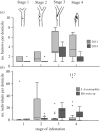Small burrowing amphipods cause major damage in a large kelp
- PMID: 32345163
- PMCID: PMC7282921
- DOI: 10.1098/rspb.2020.0330
Small burrowing amphipods cause major damage in a large kelp
Abstract
Large herbivores such as sea urchins and fish consume a high proportion of benthic primary production and frequently control the biomass of marine macrophytes. By contrast, small mesograzers, including gastropods and peracarid crustaceans, are abundant on seaweeds but have low per capita feeding rates and their impacts on marine macrophytes are difficult to predict. To quantify how mesograzers can affect macrophytes, we examined feeding damage by the herbivorous amphipods Sunamphitoe lessoniophila and Bircenna sp., which construct burrows in the stipes of subtidal individuals of the kelp Lessonia berteroana in northern-central Chile, southeast Pacific. Infested stipes showed a characteristic sequence of progressive tissue degeneration. The composition of the amphipod assemblages inside the burrows varied between the different stages of infestation of the burrows. Aggregations of grazers within burrows and microhabitat preference of the amphipods result in localized feeding, leading to stipe breakage and loss of substantial algal biomass. The estimated loss of biomass of single stipes varied between 1 and 77%. For the local kelp population, the amphipods caused an estimated loss of biomass of 24-44%. Consequently, small herbivores can cause considerable damage to large kelp species if their feeding activity is concentrated on structurally valuable algal tissue.
Keywords: Ampithoidae; Phaeophyceae; algal detritus; kelp; mesograzers; plant–herbivore interaction.
Conflict of interest statement
We declare we have no competing interests.
Figures




References
-
- Cyr H, Pace ML. 1993. Magnitude and patterns of herbivory in aquatic and terrestrial ecosystems. Nature 361, 148–150. (10.1038/361148a0) - DOI
-
- Dayton PK. 1975. Experimental evaluation of ecological dominance in a rocky intertidal algal community. Ecol. Monogr. 45, 137–159. (10.2307/1942404) - DOI
-
- Steneck R, Graham MH, Bourque BJ, Corbett D, Erlandson JM, Estes JA, Tegner MJ. 2002. Kelp forest ecosystems: biodiversity, stability, resilience and future. Environ. Conserv. 29, 436–459. (10.1017/S0376892902000322) - DOI
Publication types
MeSH terms
Associated data
LinkOut - more resources
Full Text Sources
Miscellaneous

